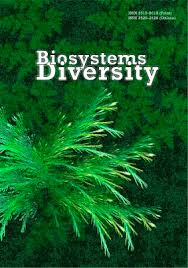Cuticular wax composition of mature leaves of species and hybrids of the genus Prunus differing in resistance to clasterosporium disease
Cuticular wax composition of mature leaves of species and hybrids of the genus Prunus differing in resistance to clasterosporium disease
Author(s): N. O. Khromykh, Y. V. Lykholat, A. A. Anishchenko, O. O. Didur, A. A. Gaponov, А. М. Kabar, T. Y. LykholatSubject(s): Health and medicine and law, Sociobiology
Published by: Дніпропетровський національний університет імені Олеся Гончара
Keywords: peach; almond; epicuticular wax; n-alkane; aldehyde; fungal damage; resistance;
Summary/Abstract: The interaction of a host plant with pathogen implies an extremely complex process involving the outer waxy layer of the cuticle, cutin, cell membrane, and intracellular structures. However, the initial contact between plants and pathogens takes place in cuticular waxes covering the surface of leaves, stems and fruits. Despite many findings on the role of plant epicuticular waxes, there is a gap in the understanding of the relationship between individual compounds and their functions. The pathogenic fungus Clasterosporium carpohilum (Lev.) Aderh. parasitizes the tissues of many stone fruit trees, damaging leaf and fruit surface. The aim of this work was to find out if the quantity and composition of leaf epicuticular wax could be responsible for the resistance to clasterosporium disease. The study of differences of plants in fungal resistance was carried out on species and hybrids of the genus Prunus from the collection of the Botanical Garden of Oles Honchar Dnipro National University (Dnipro city, Ukraine). The chloroform extracts of epicuticular waxes from the surface of mature leaves were analyzed by gas chromatography connected to mass-spectrometry. GC/MS assay was performed using Shimadzu GCMS-QP 2020 El equipped with capillary column (5% diphenyl/95% dimethyl polysiloxane), and helium as a carrier gas. Mass Spectrum Library 2014 for GSMS was used to identify the separated compounds of the wax extracts. The maximum total wax amount on the adaxial and abaxial leaf surface of hybrid 2 was twice the minimum wax accumulation for hybrid 4. Overall, 20 individual compounds belonging to six hydrocarbon classes were identified. Leaf epicuticular wax composition both in Prunus persica (L.) Batsch and P. dulcis (Mill.) D. A. Webb, and hybrids was dominated by long-chain n-alkanes with even carbon number (77.6–90.9% of total sum). The alkenes’ class was represented only by 17-pentatriacontene detected in the wax of both Prunus species. Octadecanaldehyde was found in epicuticular wax of P. dulcis while absent in wax of the more resistant species P. persica. Prime alcohols 1-tetradecanol and 1-hexacosanol were detected in leaf waxes of hybrid 4 and P. dulcis respectively. The ester class contained seven compounds found in leaf epicuticular waxes of both plant species and all hybrid forms. The identification of phthalic acid esters in leaf wax extracts was unexpected, and the phthalates’ origin is discussed. Strong positive correlation between leaf damage and tetrapentacontane content in epicuticular waxes could presumably be the result of infection-induced metabolism reprogramming in epidermal cells of infected leaves.
Journal: Biosystems Diversity
- Issue Year: 28/2020
- Issue No: 4
- Page Range: 370-375
- Page Count: 6
- Language: English

